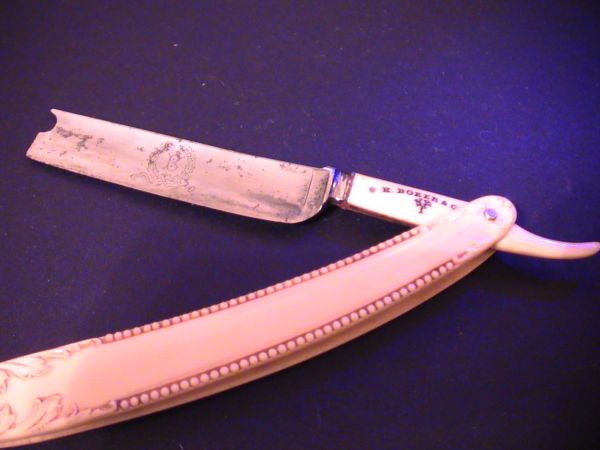Results 1 to 9 of 9
Hybrid View
-
10-16-2009, 01:50 PM #1
 Cleaning rust around a covered tang.
Cleaning rust around a covered tang.
I got a nice Boker (my first!) from a guy on craigslist yesterday and as soon as I got home I popped the scales off to start cleaning it up. The blade itself is in pretty good condition, but there's a bunch of rust right at the point where the covered tang starts.
First, I'd just like confirmation that the tang is ivory. I'm pretty sure it is but I've never seen the stuff previously to be 100% -- I'll call it ivory from here on out until someone can say that isn't.
Second, could I get some suggestions on cleaning the rust and hopefully whitening the ivory? There are pins used to attach the covering but I suspect that they couldn't be removed without damaging the ivory.
I do not have a tumbler (yet) and my cleaning supplies consist of 400- to 2000-grit sandpaper, a Dremel with felt pads, Maas, and some red polishing compound. My concerns are that trying to sand the metal might damage the ivory, and that there could be rust underneath that I can't get to.
First picture is the blade when I got it, the latter two are closeups of the tang from the top and bottom:



Thanks!
-
10-16-2009, 01:53 PM #2I shave with a spoon on a stick.



- Join Date
- Jan 2009
- Location
- Stay away stalker!
- Posts
- 4,578
- Blog Entries
- 1
Thanked: 1262
Be careful with that tang. i had a bad experience when removing one......
-
10-16-2009, 02:41 PM #3

I would not remove the tang.
I would wrap my left index finger with 600 grit sandpaper, and hold the razor blade in my right hand and basically breadknife the tang onto my sandpaper wrapped finger, trying to keep the ivory surfaces off the sandpaper if possible...carefully sanding the flat surfaces of metal...
If you are worried about hitting the ivory, don't -- you can sand up to 2000 and then use some maas on a felt pad on your dremel @ low speed and re-buff the ivory back to mirror.
Whatever you do, don't sand the word printing on the ivory ;D it will go byebye.
For the little dimple between the blade and tang there, wrap a pencil in sandpaper and sand that down...
go to 2000 grit after all rust is gone and then do the same motions with a rag /w MAAS on it (wrapped around finger, wrapped around pencil)....
thats what I'd do!
-
The Following User Says Thank You to Undream For This Useful Post:
commiecat (10-16-2009)
-
10-16-2009, 02:45 PM #4
-
10-16-2009, 04:02 PM #5


- Join Date
- May 2005
- Location
- St. Louis, Missouri, United States
- Posts
- 8,454
- Blog Entries
- 2
Thanked: 4942
Looks like French Ivory to me which means plastic basically. Be really careful as any heat or dremel type work around them can melt or rub spots. These are hard to work around even by hand.
Lynn
-
The Following User Says Thank You to Lynn For This Useful Post:
commiecat (10-16-2009)
-
10-18-2009, 02:58 AM #6

It's most likely faux ivory celluloid... one hint is the tarnish around the steel in close contact with it caused by slow gassing over the decades (most likely nothing to worry about).
Rub an inconspicuous spot like the back of the tang (if there is no stamping) or the tail with a bit of dry cotton cloth and then give it a sniff... (careful the tail is not steel, not strong and may brake easily). If you smell camphor (moth balls) then it is celluloid.
-
The Following User Says Thank You to smythe For This Useful Post:
commiecat (10-18-2009)


 LinkBack URL
LinkBack URL About LinkBacks
About LinkBacks







 Reply With Quote
Reply With Quote

